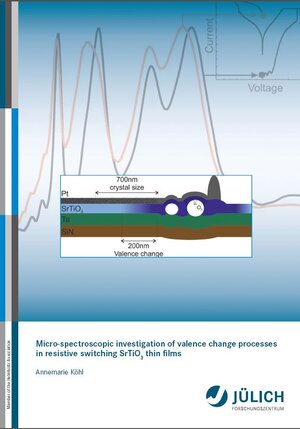
×
![Buchcover ISBN 9783893369881]()
Micro-spectroscopic investigation of valence change processes in resistive switching SrTiO3 thin films
von Annemarie KöhlDue to physical limitations of the currently used ash memory in terms of writing speed
and scalability, new concepts for data storage attract great interest. A possible alternative
with promising characteristics are so-called „Resistive Random Access Memories“
(ReRAM). These memory devices are based on the resistive switching eect where the
electrical resistance of a metal-insulator-metal (MIM) structure can be switched reversibly
by a current or voltage pulse. Although this eect attracted wide scientic as
well as commercial interest, up to now the it is not fully understood on a microscopic
scale.
Consequently, in this work the chemical and physical modications caused by the resistive
switching process are studied by spectroscopic techniques. As most switching
models predict a strongly localized rather than a homogeneous eect, advanced microspectroscopy
techniques are employed where additionally the lateral structure of the
sample is imaged. In this work Fe-doped SrTiO3 lms are used as model material due
to the thorough understanding of their defect chemistry. The epitaxial thin lms are
prepared by pulsed laser deposition.
In a rst approach, transmission X-ray microscopy is employed to study the bulk properties
of ReRAM devices. At rst, a new procedure for sample preparation based on
a selective etching process is developed in order to realize photon-transparent samples.
Investigations of switched devices reveal a signicant contribution of Ti3+ states within
growth defects. In contrast to the indirect evidence in previous studies, this observation
directly conrms that the resistance change is based on a local redox-process. The
localization of the switching process within the growth defects is explained by a selfaccelerating
process due to Joule heating within the pre-reduced defects.
In a second approach, after removal of the top electrode the chemical and electronic
structure of the former interface between the oxide lm and the electrode is investigated
by photoemission electron microscopy. Within this work devices with dierent thickness
of the oxide layer are studied. While the results for thicker lms can be explained
by a localization of the switching eect within growth defects, for lms with a lower
oxide thickness we observe a considerable modication of the chemical structure up to
phase formation on an extended lateral scale. In particular, we detect the formation
of a new, Sr-rich phase which can be modeled by a special Ruddlesden-Popper phase
using ab-initio theory. While most switching models assume only the diusion of oxygen
vacancies, our experiments clearly reveal that (at least) during forming diusion is also
enabled within the cation sublattice.
and scalability, new concepts for data storage attract great interest. A possible alternative
with promising characteristics are so-called „Resistive Random Access Memories“
(ReRAM). These memory devices are based on the resistive switching eect where the
electrical resistance of a metal-insulator-metal (MIM) structure can be switched reversibly
by a current or voltage pulse. Although this eect attracted wide scientic as
well as commercial interest, up to now the it is not fully understood on a microscopic
scale.
Consequently, in this work the chemical and physical modications caused by the resistive
switching process are studied by spectroscopic techniques. As most switching
models predict a strongly localized rather than a homogeneous eect, advanced microspectroscopy
techniques are employed where additionally the lateral structure of the
sample is imaged. In this work Fe-doped SrTiO3 lms are used as model material due
to the thorough understanding of their defect chemistry. The epitaxial thin lms are
prepared by pulsed laser deposition.
In a rst approach, transmission X-ray microscopy is employed to study the bulk properties
of ReRAM devices. At rst, a new procedure for sample preparation based on
a selective etching process is developed in order to realize photon-transparent samples.
Investigations of switched devices reveal a signicant contribution of Ti3+ states within
growth defects. In contrast to the indirect evidence in previous studies, this observation
directly conrms that the resistance change is based on a local redox-process. The
localization of the switching process within the growth defects is explained by a selfaccelerating
process due to Joule heating within the pre-reduced defects.
In a second approach, after removal of the top electrode the chemical and electronic
structure of the former interface between the oxide lm and the electrode is investigated
by photoemission electron microscopy. Within this work devices with dierent thickness
of the oxide layer are studied. While the results for thicker lms can be explained
by a localization of the switching eect within growth defects, for lms with a lower
oxide thickness we observe a considerable modication of the chemical structure up to
phase formation on an extended lateral scale. In particular, we detect the formation
of a new, Sr-rich phase which can be modeled by a special Ruddlesden-Popper phase
using ab-initio theory. While most switching models assume only the diusion of oxygen
vacancies, our experiments clearly reveal that (at least) during forming diusion is also
enabled within the cation sublattice.


